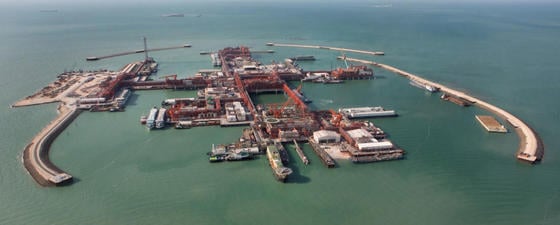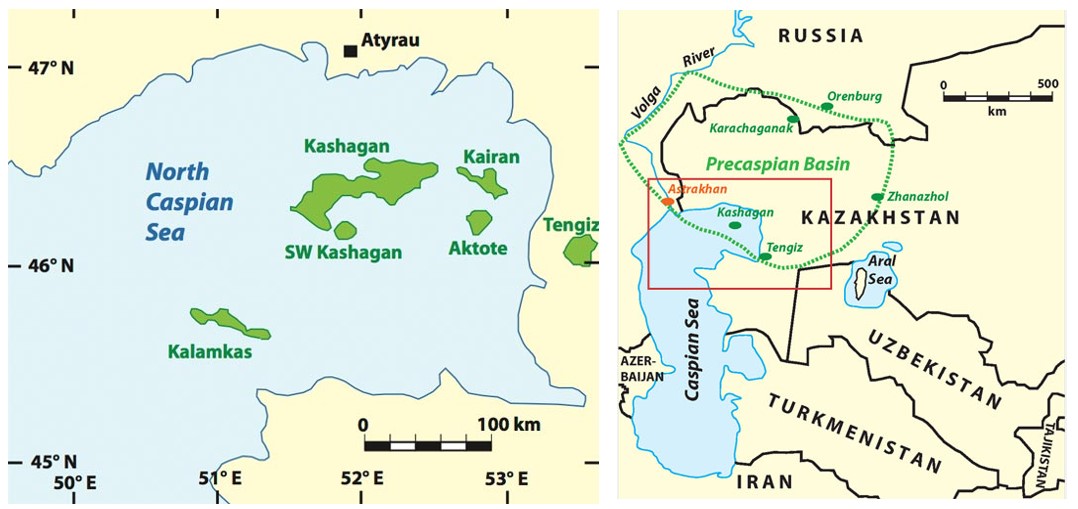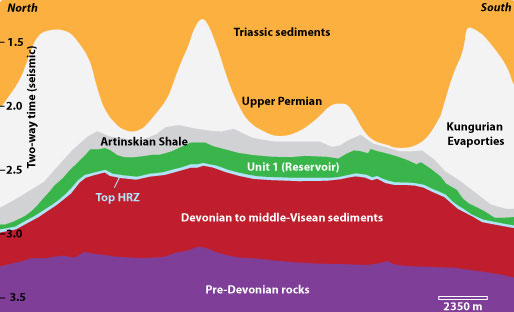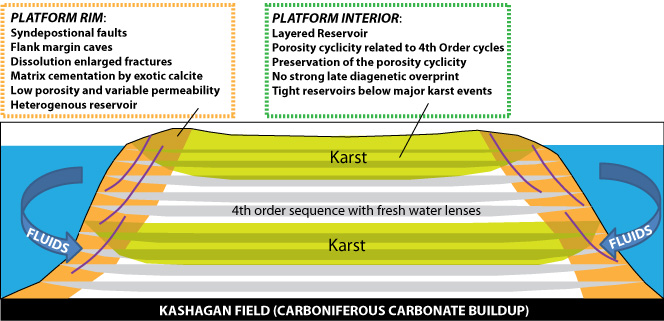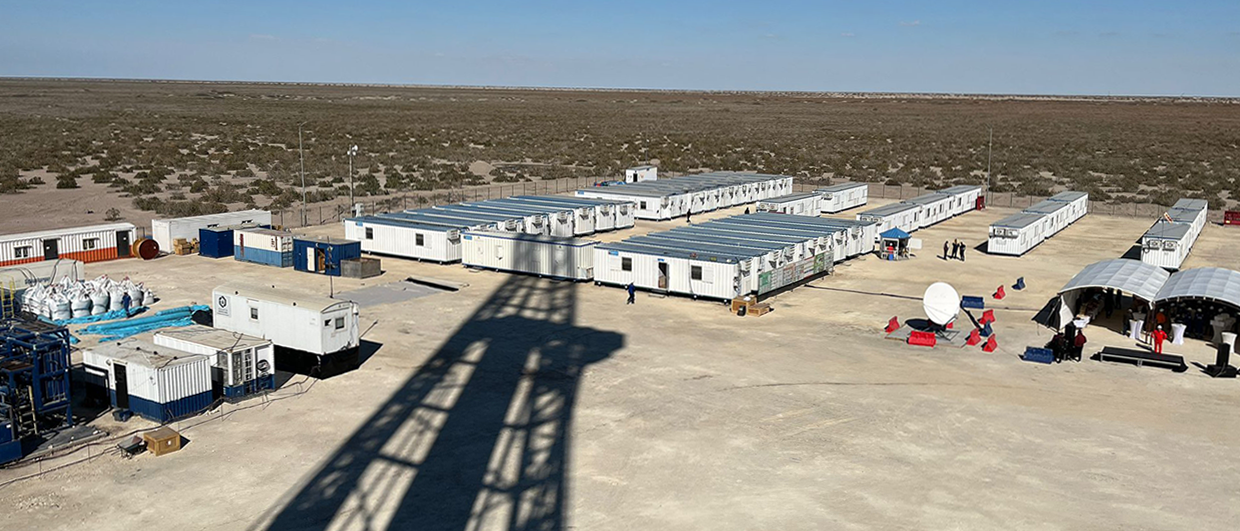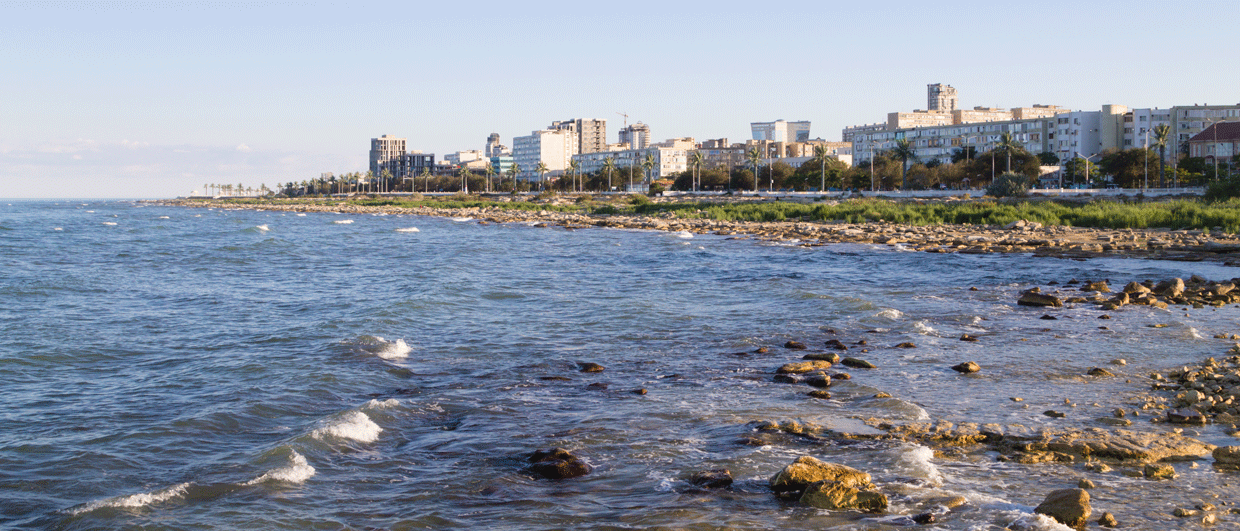Although first identified by Soviet geologists in the early 1970s, the field remained unexplored and undrilled because of complex geology, high cost, and environmental and logistical issues. After the collapse of the USSR in 1991, Kazakhstan, like the other Central Asian countries, became independent and open to international oil companies. In 1993, the Kazakstancaspiishelf consortium, consisting of Agip (Eni), British Gas, BP, Statoil, Mobil, Royal Dutch Shell and Total, together with the Kazakh government, was formed to explore the Caspian sector of Kazakhstan. The consortium carried out a 2D seismic survey, completed in 1997. In the same year, it changed its name to the Offshore Kazakhstan International Oil Company (OKIOC). In 1998, Phillips Petroleum and Japan’s Inpex joined the consortium.
Path To Discovery

The Kashagan field discovery was announced on 24 July 2000 and was named after a nineteenth-century Kazakh poet. The discovery well Kashagan East-1, spudded-in on 12 August 1999 and drilled in water depths of 3m to the reservoir at 3,960 m, hit light crude (42–44° API) and tested 3,700 bopd and 7 MMcfgpd. On 7 October 2000, another well, Kashagan West-1, was spudded-in about 40 km away from the discovery well. It was drilled in waters of 7m to a depth of 4,250m, and tested oil (42–45° API) at a rate of 3,300 bopd and gas at 7.5 MMcfgpd. Gas-to-oil ratios for these two wells were, respectively, 1,900 and 2,200 cfpbo. Within a decade, 10 appraisal and 11 development wells had been drilled.
Over the years, the Kashagan consortium has undergone many changes. In 2001, BP and Statoil sold their stakes to Total and in 2004, British Gas sold half its shares to the Kazakh government and the rest to the remaining partners. Kazakhstan’s share was then transferred to a new state-owned company KazMunayGas. In 2009, the Agip Kazakhstan North Caspian Operating Company, which had been the field’s operator since 2001, transferred its activities to the new North Caspian Operating Company (NCOC).
Currently, NCOC comprises Eni, Shell, ExxonMobil, Total and KazMunayGas, each with a share of 16.81%, as well as ConocoPhillips (8.4%) and Inpex (7.56%). Last November it was reported that ConocoPhillips intended to sell its share to India’s ONGC Videsh. This September, the Kazakh government announced it will sell 8.33% of its stake in the Kashagan field to China for about US$5 billion.
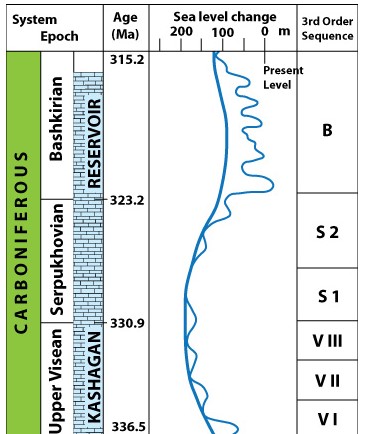
The Precaspian Basin is tectonically located on the south-eastern corner of the Russian platform (East European craton). The central Precaspian depression, filled with 20 km of sedimentary succession, sits on a remnant oceanic or a thinned lithospheric crust. Geologists do not have consensus on a tectonic model to explain the origin of the basin partly due to lack of access to the deepest sedimentary record in the central depression. It is bordered on the east by the Ural orogenic belt, which came to existence in Carboniferous-Permian times as the Kazakhstan continental block collided with the Eastern European craton (part of the Laurasian supercontinent).
The stratigraphy of Kashagan, like the other Precaspian fields, may be divided into pre-salt and post-salt successions separated by the Kungurian-age evaporites. The pre-salt succession (Middle Devonian-Lower Permian) is essentially carbonate and clay sediments, while the post-salt succession consists largely of Upper Permian-Cenozoic clastic sediments with several unconformities between various formations. The Kashagan lies in the pre-salt.
The Kashagan carbonate platform is divided into an eastern and a western part by a narrow ‘neck’ which rises about 200m higher than the flat interior of the platform. The field is tilted to the south-west so that depth to the top of the reservoir ranges from 3,800m to 4,300m. The flanks (rims) of the field dip at angles up to 25° and are affected by syn-depositional faulting, with the northern flank having a steeper slope than the southern one.
The Carboniferous sedimentary rocks of Kashagan have been divided into Unit I and Unit II, separated by a very tight shaly tuff zone of upper Visean age called Tula Shale and depicted as HRZ (high-radioactivity zone) on the logs and seismic images. Unit I (upper Visean to Bashkirian) is the main reservoir with 800m of oil-bearing column. Eni geologists have interpreted Unit I as a prograding sedimentary system (upper Visean-Serpukovian) overlain by an aggrading system (Bashkirian). Unit II is Tournaisian-middle Visean in age.
Paola Ronchi and her colleagues at Eni have conducted a detailed study of the Kashagan carbonate reservoir based on analyses of 1,500 samples from 12 wells (AAPG Bulletin, September 2010). About 80% of these samples plot in the microporous zone (pores with maximum diameter of <25 microns) and the remaining 20% range from isolated vugs to connected pore zone. For 90% of the samples, porosity ranges from 1 to 15% and permeability from 0.001 to 10 mD. Samples with very low porosity (<4%) but high permeability (0.1 to 50 mD) exhibit microfractures.
Studies by Eni geoscientists also show that in contrast to the flat stratified reservoir of the platform interior, the rims of the build-up show petrophysical complexities and can be better characterised by a double porosity-double permeability reservoir model (Panfili et al., SPE, 2012). In the platform interior, average porosity is 7% and permeability is 3 mD, while in the platform rim these values decrease to 3.5% and 0.5 mD.
The source rocks are organic-rich shale horizons of Upper Devonian and Lower Carboniferous. The cap rock is Permian shale (Artinskian age, 290–279 Ma) and salt (Kungurian, 279–272 Ma). The black shale represents a Permian flooding of the carbonate platform after a period of hiatus associated with subaerial exposure and erosion. The Kungurian salt exhibits prominent salt diapirs on the seismic images.
Huge Reserves
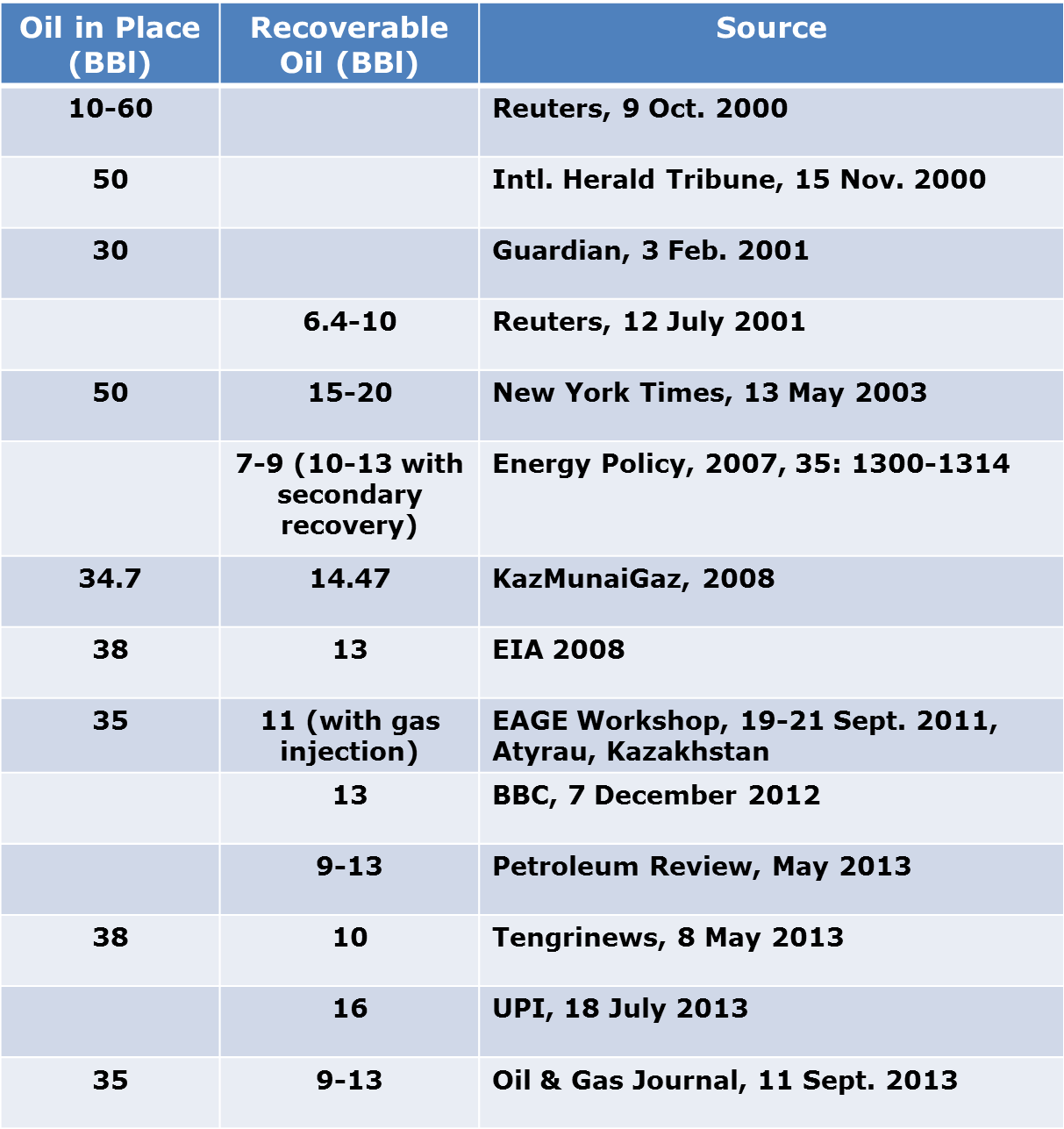
Kashagan ReservesKashagan oil is light crude (43° API) but sour with 15–19% hydrogen sulphide and 4% carbon dioxide. Gas:oil ratio averages 2,850 cfgpbo. The reservoir has abnormally high pressures (11,000 psi).
The Kashagan field is estimated to contain 35 Bbo in place, of which 10–13 Bb is recoverable oil, using gas reinjection. Kashagan is probably the largest oil field outside the Middle East and the fifth largest in terms of reserves, and may account for one-third of Kazakhstan’s current oil reserves. (The Oil & Gas Journal placed Kazakhstan’s proved oil reserves at 30 Bbo in 2012.)
According to NCOC, the Kashagan field also holds about 52 Tcf of associated gas. Most of this will be re-injected into the field both as a way of managing the highly corrosive and toxic H2S and applying an enhanced oil recovery technique (through gas-oil miscibility process). NCOC has recently started the Kashagan Experiment Program to assess and test the gas-injection logistics (Albertini et al., SPE, 2013). Some of the gas will be sent to the Bolashak processing plant where hydrogen sulphide is extracted and the ‘sweetened’ gas is then used to generate electricity. NCOC also plans to produce sulphur for sale.
Oil production from Kashagan is associated with particular challenges. Climatic conditions are extreme: -40°C in the icy winter and +40°C in the sweating summer, and sea levels fluctuate widely. During the Soviet years, the northern Caspian Sea was a nature reserve, and although the area has been open for oil and gas operations since 1992, its environmental sensitivity is still valid. Environmentalists are concerned about the impact of industrial operations on the ecological fragility of the area, which is a habitat for endangered Caspian seal, fish including caviar-yielding sturgeon, and migrating birds. Oil spills in such a shallow water environment (with little dispersion of pollutants) would indeed be hazardous to the local ecology. Although the official policy is a zero-discharge production facility, management of H2S-rich hydrocarbon in an overpressured reservoir will continue to be a technological challenge. Even with the best practices of gas re-injection and sale of sulphur products, some of the sulphur will have to be stored onshore in enclosed or underground sites requiring particular care and facilities.
Mitigating industrial footprints on the local environment and preventing ecological and health disasters will be crucial for the success of the Kashagan field operations. Meanwhile, public education and access to environmental impact assessments, health risk reports and safety information will help the HSE objectives.
Transportation of oil from Kashagan to the international markets is another area of consideration. Several pipeline options are available including those via Russia, China, Iran, Turkmenistan, or across the Caspian to Turkey. Each of these routes has its own merits and disadvantages, but to gain access to markets in Europe and Asia more than one route may be necessary. Two pipeline routes are already available for Kazakh oil: the Atyrau-Samara pipeline delivers oil to the Russian pipeline system, and the Caspian Pipeline Consortium connects Kazakhstan via Russia to the Black Sea. A new pipeline from Atyrau to Alashanjou in China is under construction, and the planned Kazakhstan Caspian Transportation System can connect Kazakh oil to the Baku-Ceyhan oil pipeline.
As of June 2013, a total amount of US$41.2 billion had been invested in Phase 1 of the Kashagan field development. During this phase, 40 wells were planned, half of which have already been completed. Initial production from these 20 wells is estimated to be 180,000 bopd, but the production is planned to increase to 370,000 bopd through the expansion of the gas handling facilities. Given the extent and volume of Kashagan, hundreds of wells will be necessary to effectively produce from this supergiant field.
Editorial Foot Note (April, 2014)
As if to reinforce the challenging nature of the Kashagan field development, a recent Wall Street Journal report entitled “$50 Billion Kashagan Oil Development Isn’t Working” highlights the technological challenges facing the development of this giant field. With so much at stake one imagines that NCOC will be keen to turn around this change of fortunes in double quick time.

